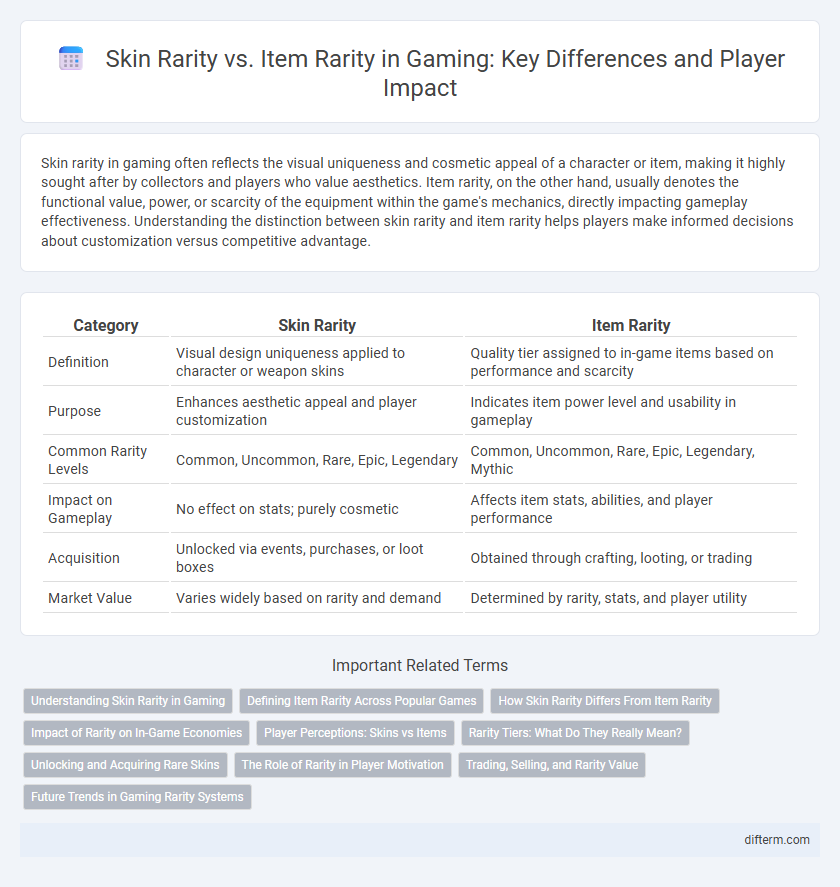Skin rarity in gaming often reflects the visual uniqueness and cosmetic appeal of a character or item, making it highly sought after by collectors and players who value aesthetics. Item rarity, on the other hand, usually denotes the functional value, power, or scarcity of the equipment within the game's mechanics, directly impacting gameplay effectiveness. Understanding the distinction between skin rarity and item rarity helps players make informed decisions about customization versus competitive advantage.
Table of Comparison
| Category | Skin Rarity | Item Rarity |
|---|---|---|
| Definition | Visual design uniqueness applied to character or weapon skins | Quality tier assigned to in-game items based on performance and scarcity |
| Purpose | Enhances aesthetic appeal and player customization | Indicates item power level and usability in gameplay |
| Common Rarity Levels | Common, Uncommon, Rare, Epic, Legendary | Common, Uncommon, Rare, Epic, Legendary, Mythic |
| Impact on Gameplay | No effect on stats; purely cosmetic | Affects item stats, abilities, and player performance |
| Acquisition | Unlocked via events, purchases, or loot boxes | Obtained through crafting, looting, or trading |
| Market Value | Varies widely based on rarity and demand | Determined by rarity, stats, and player utility |
Understanding Skin Rarity in Gaming
Skin rarity in gaming often indicates the visual uniqueness and prestige of a character's appearance, impacting player status and in-game economy value. Unlike item rarity, which directly affects gameplay mechanics such as damage or defense, skin rarity primarily influences aesthetic appeal and player customization options. Understanding the distinction helps players prioritize collectibles based on visual exclusivity rather than functional advantage.
Defining Item Rarity Across Popular Games
Item rarity in popular games is typically categorized using tiers such as common, uncommon, rare, epic, and legendary, each indicating the item's scarcity and power level. Skin rarity, distinct from item rarity, often refers to the aesthetic value and exclusivity of cosmetic items like character skins, which may include limited-time event skins or promotional items. Understanding these rarity classifications helps players prioritize resource allocation and enhances the gameplay experience through collection prestige and visual customization.
How Skin Rarity Differs From Item Rarity
Skin rarity in gaming refers to the scarcity and uniqueness of cosmetic appearances for characters or weapons, often influencing visual appeal rather than gameplay performance. Item rarity, on the other hand, denotes the level of scarcity and power of in-game objects or equipment, directly affecting gameplay mechanics and player advantage. While item rarity impacts functionality and player progression, skin rarity primarily enhances personalization and status within the gaming community.
Impact of Rarity on In-Game Economies
Skin rarity significantly influences in-game economies by driving demand and affecting market prices, often creating a speculative environment around cosmetic items. Item rarity, linked to functional or gameplay advantages, dictates player engagement and resource allocation, impacting overall game balance and economic flow. The interplay between skin rarity and item rarity shapes player behavior, trading dynamics, and the valuation of digital assets within gaming ecosystems.
Player Perceptions: Skins vs Items
Players often perceive skin rarity as a status symbol that enhances personalization and immersion, while item rarity is primarily valued for its functional benefits and in-game advantages. Skins with rare designs or limited availability tend to attract more attention and emotional investment despite offering no gameplay advantages, contrasting with item rarity which directly impacts a player's performance and strategy. This difference shapes player behavior, driving demand for cosmetic exclusivity alongside competitive edge.
Rarity Tiers: What Do They Really Mean?
Rarity tiers in gaming categorize item value and availability, differentiating between skin rarity and item rarity for players seeking exclusivity or functionality. Skin rarity often indicates cosmetic uniqueness, ranging from common to legendary, influencing player customization without affecting gameplay mechanics. Item rarity aligns with utility and power, where higher-tier items typically offer enhanced stats or abilities, crucial for strategic advantage in competitive environments.
Unlocking and Acquiring Rare Skins
Unlocking rare skins in gaming often depends on a combination of item rarity and drop rates within loot boxes or in-game events, where uncommon or legendary skins have significantly lower acquisition probabilities than common items. Players can increase their chances of obtaining rare skins by participating in limited-time challenges, completing high-level quests, or through in-game purchases tied to exclusive bundles or seasonal passes. The distinction between skin rarity and item rarity impacts market value and player status, making rare skins highly sought after for customization and prestige in competitive gaming environments.
The Role of Rarity in Player Motivation
Skin rarity significantly impacts player motivation by enhancing the perceived value and exclusivity of cosmetic items, driving engagement and prolonged gameplay. Item rarity, often tied to gameplay advantages, fuels competitive progression and strategic investment, influencing player decisions and satisfaction. Together, skin and item rarity create layered incentives that cater to both aesthetic preferences and functional goals within gaming communities.
Trading, Selling, and Rarity Value
Skin rarity and item rarity significantly impact trading and selling dynamics in gaming markets, with rare skins often commanding higher prices due to their aesthetic appeal and exclusivity. Item rarity, defined by in-game utility or drop rates, influences demand by affecting gameplay advantages or scarcity, thereby shaping market value. Traders leverage these rarity metrics to assess worth and potential investment returns, making skin exclusivity and item utility key factors in rarity value evaluation.
Future Trends in Gaming Rarity Systems
Emerging trends in gaming rarity systems emphasize dynamic skin rarity that evolves based on player achievements and in-game events, surpassing traditional static item rarity frameworks. Blockchain integration is enabling verifiable ownership and provenance, enhancing the exclusivity and tradability of rare skins and items. Procedural generation powered by AI personalizes rarity by adapting cosmetic features in real-time, increasing player engagement through unique and scarce digital assets.
Skin Rarity vs Item Rarity Infographic

 difterm.com
difterm.com